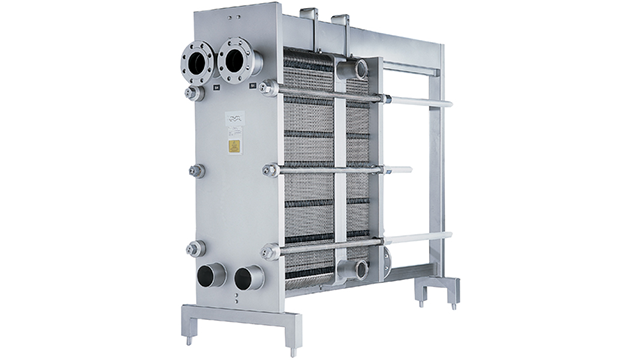Alfa Laval M series Heat Exchanger

 Alfa Laval M series Heat Exchanger
Alfa Laval M series Heat Exchanger
ABS offers Alfa Laval’s M Series plate heat exchangers as a reliable solution for general heating and cooling duties in hygienic applications. Designed for higher design pressure and extra-long plate packs, the M Series is often selected over the BaseLine range for more demanding processes.
These standard gasketed plate heat exchangers are widely used in dairy, food, beverage, brewery and other hygienic industries, providing consistent performance and long service life. Popular models include the Alfa Laval M3, M6, M10 and M15 heat exchangers, with options such as double-wall plates (e.g., M10B, M15B, M6M) for maximum safety against cross-contamination.
MODELS
-
Alfa Laval M3
-
Alfa Laval M6 / M6M
-
Alfa Laval M10 / M10B / M10M
-
Alfa Laval M15 / M15B / M15-M
Related Industries:
Processed Foods, High-Acid Foods, Dairy, Beverages, Brewery, Home & Personal Care, Pharmaceutical, Biotech, Chemical
Hygienic Design for Heating and Cooling
The Alfa Laval M line meets all hygienic requirements for pasteurization, raw milk cooling and CIP heating.
Easy Maintenance
Equipped with FDA-compliant glue-free gaskets, the M Series is easy to open for inspection, cleaning and Cleaning-in-Place (CIP). Plates can be added or removed as process requirements change.
Plate Options
-
Chevron plate pattern – Ensures high thermal efficiency and fluid distribution.
-
Gemini double-wall plates – Prevent cross-contamination by separating fluids, making models like M10B double-wall or M15B double-wall ideal for sensitive applications.
Competitive and Flexible Choice
Applications include:
-
Simple pasteurization
-
Raw milk cooling
-
Utility media heating/cooling
-
CIP heating
For more heat-sensitive products containing fibers or pulp, the Alfa Laval FrontLine series is recommended.
The M Series gasketed plate-and-frame heat exchanger consists of corrugated plates with gaskets that seal the channels. Fluids flow in alternate channels, typically in a counter-current pattern, ensuring the highest possible thermal efficiency.
With chevron corrugations, multiple pressing depths and a chocolate pattern distribution area, the M Series ensures complete surface utilization, avoids stagnant zones and reduces fouling.
High turbulence improves heat transfer, while Alfa Laval engineers balance thermal performance with optimized pressure drop.
Alfa Laval M series Heat Exchanger Application
An Alfa Laval M Series plate heat exchanger is an efficient solution for general heating and cooling duties in hygienic applications. In addition, the series is a perfect alternative for heating and cooling service media, including portable water, glycol and chilled water tempering.
Materials
| M3 | M6 | M10 | M15 | |
| Frame plate | Mild steel, epoxy painted | Mild steel, epoxy painted | Mild steel, epoxy painted | Mild steel, epoxy painted |
| Ports | 316, Titanium** | 316, Titanium** | 316, Titanium** | 316, Titanium |
| Plates | 304, 316, Titanium | 304, 316, Titanium | 304, 316, Titanium, Alloy 20/18/6 | 304, 316, Titanium, C-276, 254 SMO |
| Gaskets | Nitrile, EPDM, HeatSeal F* | Nitrile, EPDM, HeatSeal F* | Nitrile, EPDM, HeatSeal F*, HNBR*, EPDMF*, Viton® G* | Nitrile, EPDM, AL-EPDM, Nitrile hydrogenated, Viton G |
*Available only with specific plate types within the models
**Studded flange-style ports available in carbon steel with optional liners
Working Principle
Channels are formed between the plates and the corner ports are arranged so that the two media flow through alternate channels. The heat is transferred through the plate between the channels and complete counter-current flow is created for highest possible efficiency. The corrugation of the plates provides the passage between the plates, supports each plate against the adjacent one and enhances the turbulence to bring you efficient heat transfer.
Standard Design
The plate heat exchanger consists of a pack of corrugated metal plates with portholes for the passage of the two fluids between which heat transfer will take place.
The plate pack is assembled between a fixed-frame plate and a movable pressure plate and compressed by tightening bolts. The plates are fitted with a gasket that seals the interplate channel and directs the fluids into alternate channels. The number of plates is determined by the flow rate, physical properties of the fluids, pressure drop and temperature program.
The plate corrugations promote fluid turbulence and support the plates against differential pressure. The plate and the pressure plate are fixed between the upper bar and lower bar, both of which are fixed to a support column.
Connections are located in the frame plate or, if either or both fluids make more than a single pass within the unit, in the frame and pressure plates.
Alfa Laval M line plate-and-frame heat exchangers.pdf
Alfa Laval M-Serie-BaseLine-FrontLine Gemini plate-and-frame heat exchangers.pdf
Need a reliable heat exchanger for your industrial or utility process? Contact us to configure the ideal Alfa Laval M Series unit for your application.
